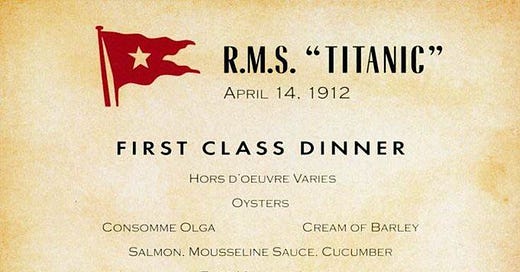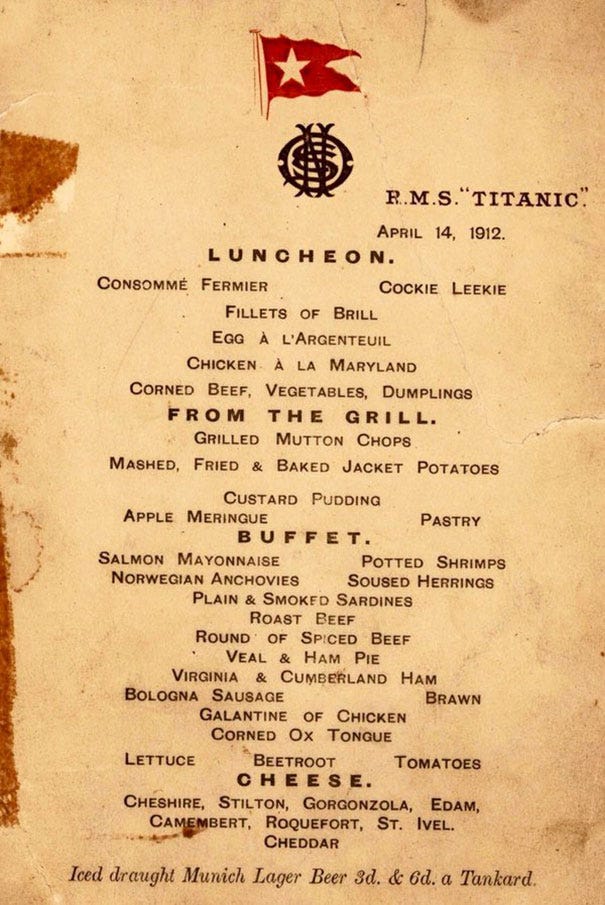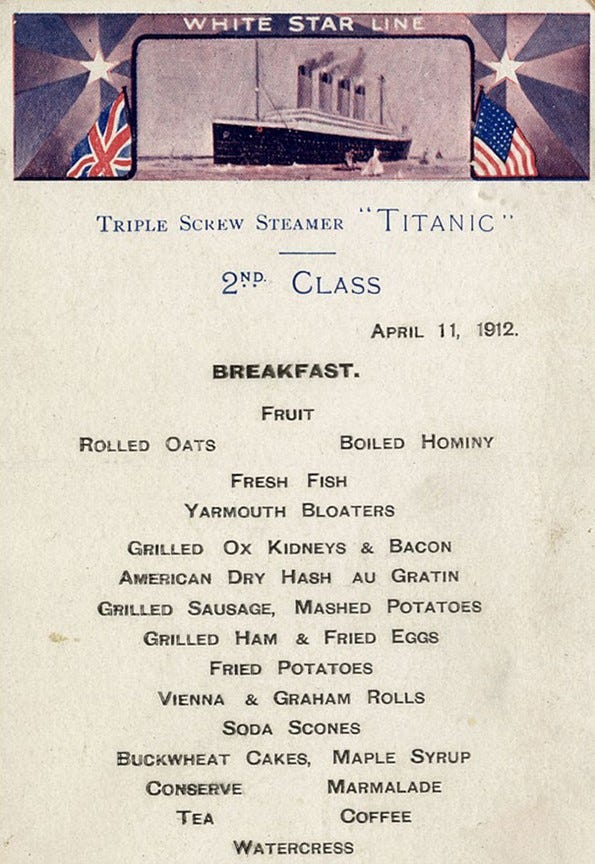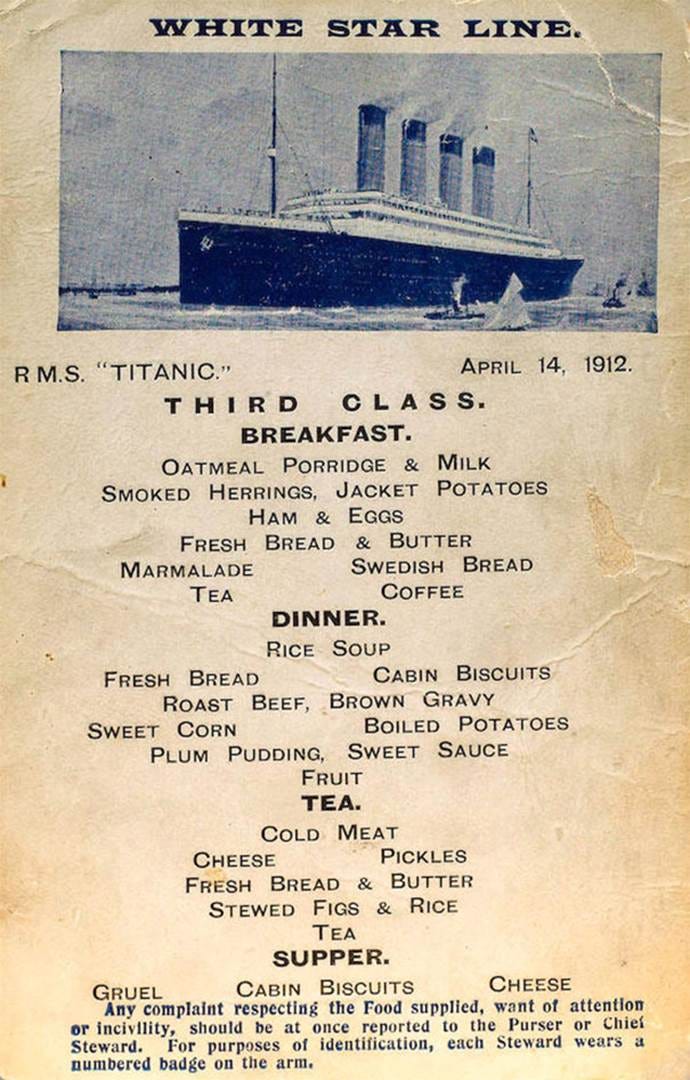This week is the 113th anniversary of the Titanic sinking.
Not a reason for celebrating, but I recently found more letters from my grandfather. He had just come off the R.M.S Carpathia, with his brother, my great uncle Billy. After it picked them up from the waters around the sinking Titanic, and set them down in Southampton. He wrote “My valet aboard the rescue ship RMS Carpathia discovered this menu folded in the breast pocket of my evening clothes, the same ones I was wearing in the life-boat. The menu was titled: “Banquet Offert par M. Bruce Ismay aux Passengers de 1ère Classe, R.M.S. Titanic.”
Bruce Ismay was chairman of the White Star Line and who survived the sinking of the Titanic by escaping into a life boat meant for women and children only.
(Here is his menu, and here offered without the accents).
Hors d'oeuvre varies
Huitres
Pate se saumon, sauce Gribiche
Filet mignon a la Lili
Quenelles a la Lyonaise
Roti de mouton sauce menthe
Rognons avec pommes paille
Carrottes nouvelles a la crème et pommes nouvelles
Punch Romain
Pigeons rotis, salade cresson
Asperges sauce blanche
Pate de foie gras
Salade de celery
Pudding Waldorf
Gelee de peche a la Chartreuse
Gateau au chocolat et a la vanille
Crème glacée francaise
The Iced Crème is the “French Ice Cream” offered to all in First Class a few hours before the Royal Mail Ship (R.M.S.) sank.
“I thought many times of the irony that for many, before hitting the icy waters and then drowning in it, the iced cream was their last memory, other than the two-and-a-half hours the ship took to sink. Watching it happen has erased all memory of what those dishes were like. All I remember is Billy taking two bottles of “Napoleon” Cognac into the lifeboat to help the blankets prevent us from freezing to death.”
POST-TITANIC “THIGHS OF NYMPHS,” LONDON, 1912
In London just after the disaster, my grandfather and his brother Billy had a survivor dinner at the Savoy with Ivor Novello. When Escoffier came out into the dining room and saw them, he came over to say he was glad they had not drowned, even if now it looked like they were in celebratory champagne. He gave each of them a copy of his latest edition of his magazine, Le Carnet d'Epicure.
When I inherited that copy, I saw that it had the recipe for his newest creation, a folly of a gourmand he said, so he called it "Salade Folle Gourmande." And must have been its first appearance. Later in the century became its most ubiquitous salad, with all sorts of Young Turks of all countries claiming to have invented it. The original was a combination of red partridge roasted on the spit, the breast meat filleted, slices of black truffles in abundance, poached crayfish tails, and the white of celery, all of it well seasoned with salt and freshly-ground pepper, fine virgin olive oil from Provence, and some delicious Dijon mustard.
In my father’s diary-notebooks I read about the famous “Thighs of Nymphs.” Long since gone perhaps having something to do with the environment, now endangered and becoming far less Edwardian than it had been.
“The very last time I had them was years later, the same evening a famous ducal-drunkard-around-town drove backwards through the dining room window from the Savoy’s entrance after too much after-dinner brandy, thinking the ‘R’ on his Daimler automatic transmission stood for “renversée,” or the inverted custard upon which Les Cuisses de Nymphes à la Belle Aurore rest when presented.”
“Certainly, the sun was coming up when we finally were able to leave the Savoy, though the aurore was anything but beautiful as I looked out the car’s window. We were still in the dining room and about to leave and all I could see was open-mouthed and horrified New Year’s revelers, including a surgically-enhanced fake duchess badly and tightly disguised with faux jewels, the real ones having been hocked to gold-plate her former husband’s (the driver) car.”
The management probably knew that the ghost of Escoffier would have been aghast at having a limousine in his dining room instead of something cooked à la Limousin. So off with the dish’s head, as it were, though this time it was thighs and the nymphs were never seen again. After that the Aga Khan had to make do with Fernand Point’s grenouilles en débrouille or frogs’ legs in scrambled eggs (the French creamy kind), but those were the legs, the thighs having been commandeered by his son Aly.
These days we might have to do merely with “A noble aphrodisiac” of frogs’ legs from Norman Douglas’ Venus in the Kitchen. That recipe calls for sauce poulette, which has nothing to do with chickens or smooth-thighed ladies of the night except for the egg yolks in the sauce.
But back to Escoffier and the history of the thighs of nymphs.
Some women who ate frogs thought of themselves as ladies, and some of them seen in public at the Savoy, actually were, since it was now socially acceptable to be seen in a dining room after the theatre. Encouraged by the soft pink shades lamps and lighting just invented by Richard D’Oyly Carte for the hotel, the proper flowers fresh and in abundance from Covent Garden nearby, and the fact that Ritz loved women and thought they should be allowed out at night, the ladies showed up to eat in public at the Savoy. Lily Langtry (no Lady, but very nice), Lady Dudley, Jennie Jerome or Lady Randolph Churchill (slightly more of a lady than her allegedly syphilitic husband), the Countess de Grey - all were dining companions of the Prince of Wales, and all enjoyed the delicate, exquisite, and beautiful food of Escoffier.
Exquisite tends to pall, however, especially if there is a lot of it around. So, the Prince asked Escoffier one day to produce a surprise for an after-theatre intimate supper. In came thighs of nymphs at dawn since French frogs’ legs are often called cuisses des nymphes, or nymphs’ thighs, naked or not. The delicious white meat in its pale-pinkish chaud-froid sauce was surrounded by wilted sprigs of tarragon the greenery as in John William Waterhouse’s erotic “Hylas and the Water Nymphs” of 1896. All was mystery and, in the presence of the Prince, no one dared ask what, exactly, they were eating.
The next morning came a call from Marlborough House. HRH wanted to know WHAT those “nymphs” were. Our man Auguste had to tell the horrified equerry that the nymphs were frogs, the paprika-hued wine sauce was the dawn, the tarragon the pond weed in which the nymphs were known to frolic. No true Englishman not a lady had ever eaten frog. But now that Albert Edward had, they were the rage of tout London. Even with some of the more adventurous ladies, now they knew what was what. Escoffier became known, amongst other things, as the man who taught the English to eat frogs, especially when it meant that the endless sugared buns and jellied cakes at afternoon tea were abandoned for elegant French food.
As the novelist and my hero Norman Douglas once said: “When, if they ever, the dog days set in, eat frogs. Or any thighs lit by the auroral light of the rising sun.”
With no frogs around, poached chicken will do. Perhaps with Mousseline sauce.
Here from Escoffier.
Consommé Olga
A clear veal stock enriched with mince beef or veal, poured very hot into a soup plate in which there are sticks of celery root, English cucumber, and carrot. And a quarter of its volume of port wine to add festivity.
Mousseline Sauce
Hollandaise sauce into which half of its volume of unsweetened whipped cream is folded.
Poulet Sauté Lyonnaise
“Sauté the chicken in butter and, when it is half-cooked, add three fair-sized onions, finely sliced, tossed in butter and slightly colored.
Complete the cooking of the chicken and the onions together, and dish the former. Swill with one-sixth pint of veal gravy; reduce; pour this liquor and the onions over the chicken, and sprinkle the whole with a pinch of chopped parsley.”
Everyone ate well:
Thank you for reading Out of the Oven. If you upgrade for the whole experience, and pay $5 a month or $50 a year, you will receive at least weekly publications, as well as menus, recipes, videos of me cooking, and full access to archives.









Hi Olga and many thanks for this. I had those menus and should have kept them instead of donating them. Un ciao e abraccio back to you.
And thank you, Mark!